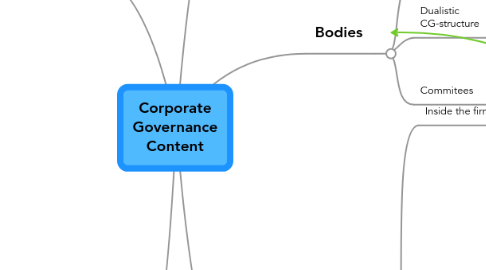
1. "Soft determinants"
1.1. Business principles
1.1.1. Mission
1.1.2. Vision
1.1.3. Values
1.1.3.1. Integrity
1.1.3.2. Physical
1.1.3.3. Organizational
1.1.3.4. P
1.2. Business conduct
1.3. Compliance
1.3.1. to stick to the rules
1.3.2. tools
1.3.2.1. rules and regulations
1.3.2.2. Control
1.3.2.3. Internal Audit
1.3.2.4. External Audit
1.3.3. rules
1.3.3.1. compulsary legislation
1.3.3.2. voluntary regulations
1.3.3.2.1. e.g. corp gov codi
1.3.3.3. internal company regulations
1.3.3.3.1. statutes
1.3.4. non-compliance
1.3.4.1. monetary costs, e.g. penalties
1.3.4.2. non-monetary cost, e.g. loss of reputation
2. Functions
2.1. Transparency
2.1.1. Objective
2.1.1.1. Inform shareholders and public
2.1.2. Disclosure
2.1.2.1. financial data
2.1.2.2. "Narratives"
2.1.2.2.1. about business
2.1.2.2.2. riks
2.1.2.2.3. future plans
2.1.2.2.4. relationship with stakeholders
2.1.2.2.5. info on sustainability and CSR
2.2. Reporting
2.3. Risk Management
3. Bodies
3.1. Monoistic CG-structure
3.1.1. Supervisory Board
3.1.2. Executive Board
3.2. Dualistic CG-structure
3.2.1. Board of directors
3.3. Commitees
3.3.1. audit committees
3.3.2. remuneration com.
3.3.3. can be created for all purposes
4. Legal institutions
4.1. Inside the firm
4.1.1. corporate contracts
4.1.1.1. statutes
4.1.2. bylaws
4.2. From the state
4.2.1. Legal framework
4.2.1.1. Constitution
4.2.1.2. Specific law regarding constitution of company
4.2.1.2.1. e.g. stock corporation act
4.2.1.3. Participation law
4.2.1.4. Law on modus operandi
4.2.1.4.1. e.g. law on management remuneration
4.2.2. Corporate Governance Codex
4.2.2.1. code-specific characteristics
4.2.2.1.1. Germany
4.2.2.1.2. UK
4.2.2.1.3. USA
4.2.2.1.4. Netherlands
4.2.2.1.5. OECD
5. Underlying Theories
5.1. Principal-Agent-Theory
5.1.1. Managers act in their interest, but not in the owner's (shareholder) one
5.2. Stakeholder Theor
5.3. Transaction cost economics
5.4. Stewardship Theory
5.5. Class Hegemony
5.5.1. elite recruits itself
5.5.2. from management to supervisory board
